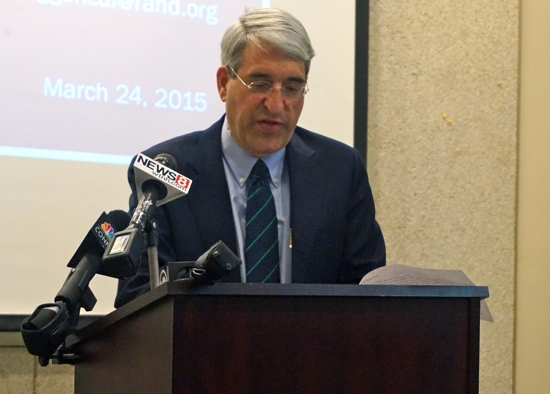
Since the start of New Haven’s “school change” reform drive, teacher and student satisfaction has improved. Test scores have increased in struggling schools. More students are prepared to enroll in college.
But test scores are still well below the state average. And parents want more personalized attention in larger schools.
Researcher Gabriella Gonzalez presented these findings from an outside study by the Rand Corporation, which analyzed data from 2010 through 2013 to determine whether the school change reform and New Haven Promise scholarship program have been successful.
District staff, city representatives and community members filled Co-op High School’s auditorium Tuesday to hear about the progress the schools have made and how far they have to go.

New Haven Promise directors hired RAND to see whether the two initiatives are “achieving their ambitious goals,” said board chair and Yale University President Peter Salovey (pictured).
It’s difficult to tell exactly which individual efforts led to overall progress in the public schools, Gonzalez said. “By design,” overlapping efforts created an overall “system of change within the district,” she said.
In order to “get a handle on the breadth of change that could be happening in New Haven,” she said, the study looked at five core areas: school and district climate, test scores, drop out rates, college enrollment rates and college preparation. Researchers compared New Haven Public Schools data before and after the reform and they compared the district to 40 peer districts in the state. They looked at factors including teacher evaluation scores, student and teacher characteristics and differences in school tiering, Gonzalez explained.
The study found that satisfaction with schools had increased from 2010 to 2011, and then stabilized there. But parents at larger schools felt “slightly disengaged” and wanted more individualized attention, she reported.
Connecticut Mastery Test and Connecticut Academic Performance Test scores increased mostly for schools that were at the time labeled tier III — those slated for turnaround. These struggling schools “had the largest gains,” especially in their math scores. But the district average is still well below the state average, Gonzalez said.
A year after the widely lauded 2009 school reform push, the city worked with Yale University to create New Haven Promise, which offers high-achieving New Haven students up to full tuition at any public state college or university.

Aliyya Swaby Photo
Almost all students who get a scholarship through New Haven Promise decide to go to college, said the program’s executive director, Patricia Melton (pictured).
Rand researchers interviewed focus groups of Promise students and parents in 2013. For quantitative data, they tracked several student performance factors, in order to determine the percentage of students over time who meet the current eligibility criteria for the program.
The data showed an increase from 28 to 36 percent of students met three of the five Promise eligibility criteria. Most students were continuously enrolled in high school and many had good attendance records, but fewer were meeting the 3.0 eligibility requirement, Gonzalez said.
The interviews with students showed the Promise scholars in 2013 “didn’t feel adequately prepared for the rigors of college,” especially those who were first-generation college students, minorities, or struggling in school. “They felt like they were really struggling in school,” because of the lack of skills such as time management and self-discipline, Gonzalez said.
Families and students said the scholarship changed their options for post-secondary education, making it easier for students to attend four-year colleges instead of two-year colleges without racking up large amounts of debt, she said.
Superintendent Garth Harries said the district has improved on those results in the past couple of years. “We have a huge amount to be proud of and we have a huge amount more work to do,” he said. The district is now focusing on rolling out new initiatives to increase communication between school staff and families, including PowerSchools, an online program that allows parents access to their children’s school progress. And schools are being encouraged to hold more individual parent-teacher nights, in order to offer personalized attention in larger schools.
“We are far away from that goal of closing the [achievement] gap” between the district and the state average, Harries said. But the district has revised its goals for reform as it sees more success, such as increasing the percent of students who make it to sophomore year in college to 50 from 36 percent. Click here to read the January report on updated reform goals.